|
Using Primary Sources in the Classroom
NOTE: This information is reproduced from the Library of Congress
Learning Page website.
http://memory.loc.gov/learn/lessons/primary.html
Suggestions for using primary sources were
compiled from the National Digital
Library's
Educators'
Forum held in July, 1995 and from
the Library staff. Educators at the Forum, like many throughout
the country, know that history comes alive for students who are
plugged into primary sources. These suggestions for student activities
can help you enhance your social studies curriculum using authentic
artifacts, documents, photographs, and manuscripts from the Library
of Congress Historical Collections and other sources.
Objects | Images | Audio | Statistics | Text | The Community
Objects
Sample Primary Sources: artifacts,
tools, weapons, inventions, uniforms, fashion
Make a hypothesis about the uses of an unknown
object pictured in an old photograph. Use online and library
research to support or refute the hypothesis. Make a presentation
to the class to "show and tell" the object, hypothesis,
search methods, and results.
Use old photographs to study fashion trends. How has fashion
changed over time? How did clothing styles reflect people's
work and their roles in society? What clothing styles have
carried over into present times?
Study old photographs to trace the development of an invention
over time (examples: automobiles, tractors, trains, airplanes,
weapons). What do the photographs tell you about the technology,
tools, and materials available through time? Who used the invention
in the past? How is the invention used today?
Sample Primary Sources: tombstones
Write an obituary for a person memorialized on an old tombstone.
Use information from the epitaph and research about the era
in which the person lived. Research the meaning of stone carvings
that appear on the tombstone. Study epidemic illnesses or other
circumstances the might explain common causes of death at the
time. |
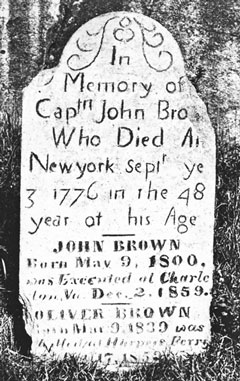 New York Monuments. Grave of John Brown.
New York Monuments. Grave of John Brown.
New York State Archives. |
Back to Top
Images
Sample Primary Sources: photographs,
film, video
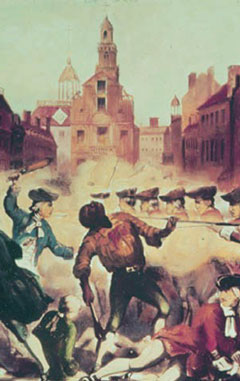 Boston
Massacre, March 5, 1770.
Boston
Massacre, March 5, 1770.
Copy of chromolithograph by John Bufford after William L. Champey, ca. 1856. |
Use a historic photograph or film of a street scene. Give
an oral description of the sights, sounds, and smells that
surround the scene, presenting evidence from the photograph
itself and other sources about the time period. Examine the
image to find clues about the economics and commerce of the
time.
Select a historical photograph or film frame. Predict what will happen one
minute and one hour after the photograph or film was taken. Explain the reasoning
behind your predictions.
To encourage focus on detail, show a photograph or film
frame to the classroom for three minutes and then remove
it. Have students draw the contents of the image on a piece
of paper divided into a grid of nine sections. Repeat this
exercise with new images and watch students' ability to recall
detail improve. Sample Primary Sources: fine art
Select a piece of fine art that appeals to your senses.
Research the artist, the date of the piece, and the medium.
What does information about the artist, the medium, the subject,
and the composition tell you about the prevailing attitudes
and conditions of the time period? (For example, what symbolism
is used? how is perspective used? in what roles are people
portrayed? what is left out of the composition?) |
Back to Top
Audio
Sample Primary Sources: oral
histories, interviews
Research your family history by interviewing relatives. Use letters,
audio recordings, and videotape to compile a report on an important
time for your family. Make note of differing recollections about
the same event.
Work in teams to record interviews of older citizens in the community. Focus
on and compile interviews on one aspect of community life such as work, family,
or schools. Combine class reports with historical images and documents to
produce a documentary on the history of your community.
Sample Primary Sources: music
Research and study lyrics of popular songs from the periods
of World War II, the Korean War, and the Vietnam War. What
do the lyrics tell you about public attitudes toward the war?
Interview veterans of these wars about their perception of
the accuracy of the information in the lyrics.
Have students search for events that have inspired lyrics
in current popular music. Have students compare present day
events and music to lyrics from the past inspired by historical
events. What are the similarities and differences between present
day and historical songs and the events that inspired them?
Sample Primary Sources: audio recordings
Introduce an audio recording of a famous political speech.
Ask students to think about and write down impressions while
they listen to the speech. What is the speaker's key message?
What is the speaker's point of view? How does the speaker's
oratory style affect the impact of the message? If the text
of the speech is available, have students compare impressions
from hearing the speech to impressions from reading the speech.
|
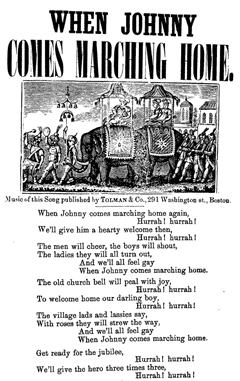 When Johnny comes marching home.
When Johnny comes marching home.
Johnson, Song Publisher, Phila. [n. d.]
Library of Congress. |
Have students listen to audio recordings from old radio broadcasts.
Compare the language, style of speaking, and content to radio and
television programs today. How does the content of the older radio
broadcast exemplify the events and prevailing attitudes of the time?
How does modern radio and television programming exemplify events
and attitudes of the present time?
Back to Top
Statistics
Sample Primary Sources: census data, land surveys,
maps, ordinances, blueprints, or architectural drawings
Study historical maps of a city, state, or region to find
evidence of changes in population, industry, and settlement
over time. Use other resources to find and report on causes
for the changes you find. Use maps to illustrate your descriptions
of these changes.
Choose a famous, historical, public building in your area.
Research blueprints or architectural drawings of the building.
With help from an architect or librarian, compare the plans
to the building as it exists today. What changes do you see?
Why do you think the changes occurred?
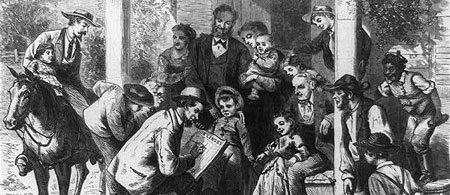
Taking the census (after sketch by Thomas Worth). Harper's Weekly, 1870 Nov. 19, p. 749
|
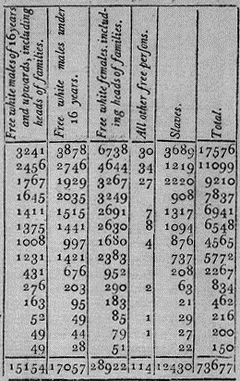 Kentucky census. Leaf inserted in 1st ed. of 1st
census 1790 at p. 51.
Kentucky census. Leaf inserted in 1st ed. of 1st
census 1790 at p. 51.
Philadelphia: Printed by Childs and Swaine,
1791. Library of Congress |
Back to Top
Text
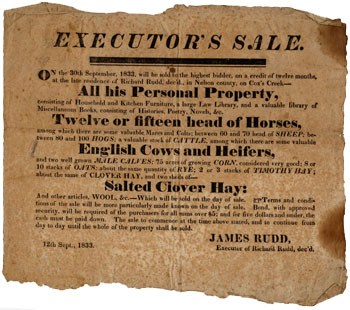
The Filson Historical Society. On deposit at the Library of
Congress. |
Sample Primary Sources: advertisements
Use old catalog pages to research fashion trends, household
articles, cost of living, and lifestyles of a particular
period. Use other sources of information to reconstruct a
picture of family life at the time. Who did the household
purchasing? What were considered necessities of the time?
What were considered luxuries? How do the catalog pages highlight
attitudes of the time?
Use newspapers over time to analyze advertising. Have students
research advertisements for a particular type of product
(clothing, tools, household appliances, automobiles) through
history. What information do the advertisements contain?
What claims do they make? Who is the target buyer? How has
advertising for this product changed over time? What social
changes are reflected by changes in advertising for this
product? |
Sample Primary Sources: journals, letters, diaries
Find first hand accounts of historical events written by children
or young people (example: Diary of Anne Frank). Analyze how first
hand accounts give context to historical events. Have students begin
keeping their own journals with an emphasis on including current
events topics in their entries.
Select a time period or era. Research and read personal letters that
comment on events of the time. Analyze the point of view of the letter
writer. Compose a return letter that tells the author how those historical
events have affected modern society.
Read a personal diary from a historical period. Analyze the individual's
character, motivations, and opinions. Explain how the individual
changed over the course of the diary. How might that person react
if they were dropped into the present time?
Sample Primary Sources: cookbooks
Research the recipe for a common food (examples: bread, cake)
in cookbooks of different times. Report on differences in the
vocabulary of the cookbooks over time. How have terms for measurement,
ingredients, portion size, and accompaniments changed? Prepare
the food from recipes of two of the time periods you find.
Hold a taste test of the end results.
Select a cookbook from another era. Look at the ingredients
lists from a large number of recipes. What do the ingredients
lists tell you about the types of foods available and the lifestyle
of the time? |
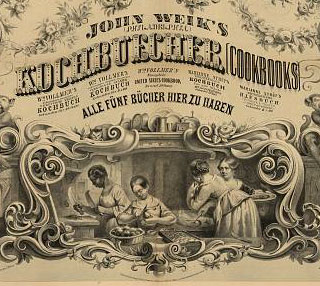
Life preserver. John Weik's (Philadelphia) Kochbuecher
[cookbooks] Lithograph. c1856. Library of Congress |
Sample Primary Sources: documents in the original handwriting or
language
Decipher the original text of a famous document (examples: The Constitution,
The Bill of Rights) by decoding historical lettering, spelling, grammar,
and usage. Compare the original writing with printed versions of
the document today. What has changed?
To help illustrate the writing
process, study draft copies of famous documents. Look at how side
notes, additions, and crossed out words
were used to edit the document. Discuss how the changes affected
the meaning of the finished work. Have students practice editing
their own writing using similar tools.
Back to Top
The Community
Sample Primary Sources:
family photographs (of ancestors and their homes), memorabilia,
souvenirs, recipes, ancestors' clothes, ancestors' papers, oral
histories, local historical societies, genealogical information
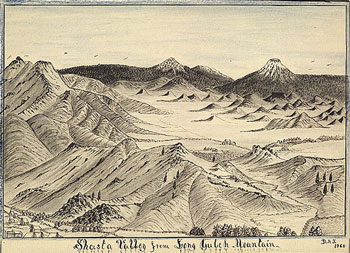 From the diary of Daniel A. Jenks, drawing on paper with
From the diary of Daniel A. Jenks, drawing on paper with
graphite,
ink, and crayon. 1860. Library of Congress. |
Make a record of family treasures (books, tools,
musical instruments, tickets, letters, photographs) using photographs,
photocopies, drawings, recordings, or videotapes. Put the treasures
into the larger historical context of local, state, country,
or world events. What was happening in the world when ancestors
were using the family treasures? How did those events affect
your family?
Find original letters from an ancestor. Read the
letters and then research
the time and events surrounding the letters in other sources. Analyze the
opinions and views of the letter writer based on the time and
events of the period.
|
Trace your ancestry to a country or countries of origin. Research
customs, language, dress, foods, and cultural traditions of your
ancestral country or countries. Prepare a class presentation of your
cultural background. Include exhibits and recipes or prepared foods
from your ancestral country. Describe how your family came to live
in your community today.
Prepare a community time capsule with the class. What primary sources
will you include to describe your present day community for future
generations? What important information do you wish to convey? Which
primary sources will get your message across? When should your time
capsule be opened?
Sample Primary Sources: physical surroundings
Research the history of famous buildings and popular sites
in your community through the local library or historical society.
Use disposable cameras to make a visual record of those sites
in the community as they appear today. Compare historical descriptions
and older pictures of sites with your own photographs. What
changes have occurred? Why?
Trace the age of buildings in your community. What is the
oldest structure? What is the newest structure? Research styles
of architecture, commonly used building materials, and the
role of buildings through time. How do your community's buildings
reflect the evolution of architectural styles and community
institutions?
|
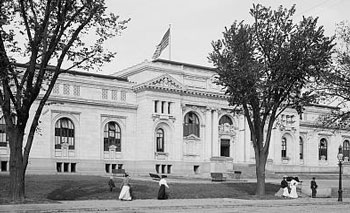 Photograph of the Carnegie Library. c1906. Detroit Publishing
Company. Library of Congress.
Photograph of the Carnegie Library. c1906. Detroit Publishing
Company. Library of Congress. |
| With the help of a local historical society, organize a tour
of older homes in your community. Research the age and historical
period of interesting houses you find. Who lived in these homes
when they were first built? How do the style and location of
the homes reflect the role of the original owners in the community?
Research and describe furnishing and decorating styles from the
time the homes were built. Do the homes look different today? |
Back to Top
|
